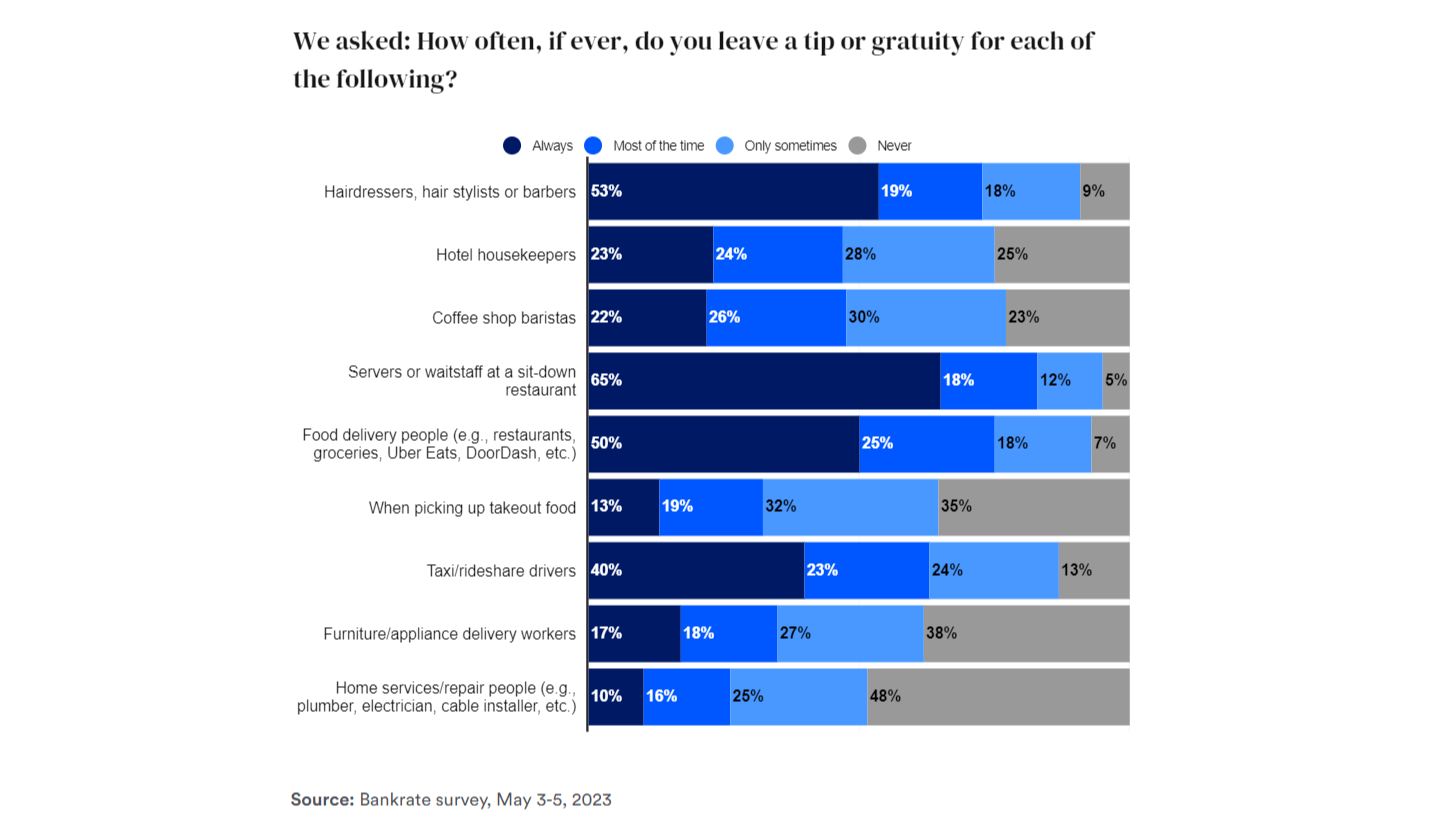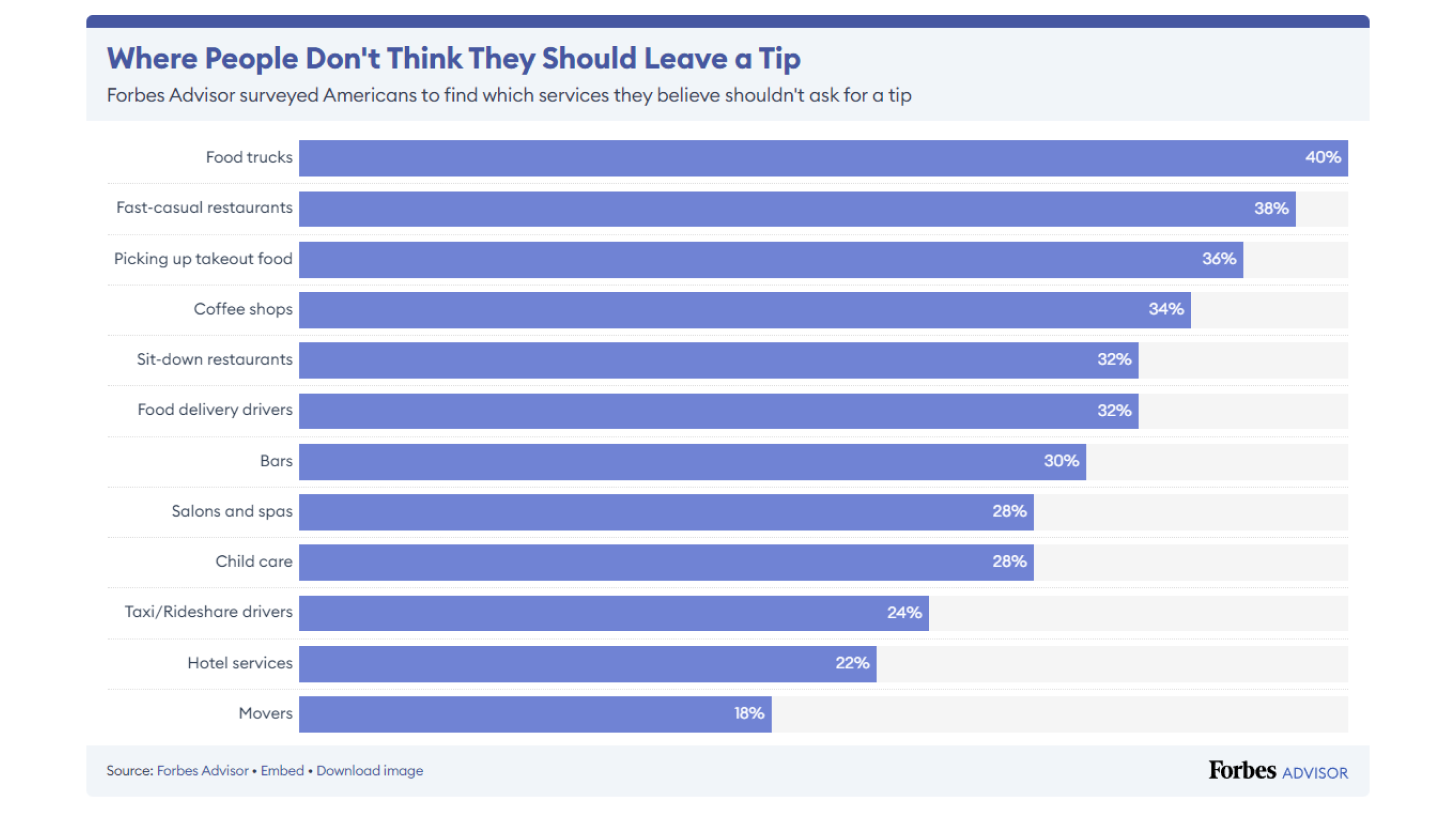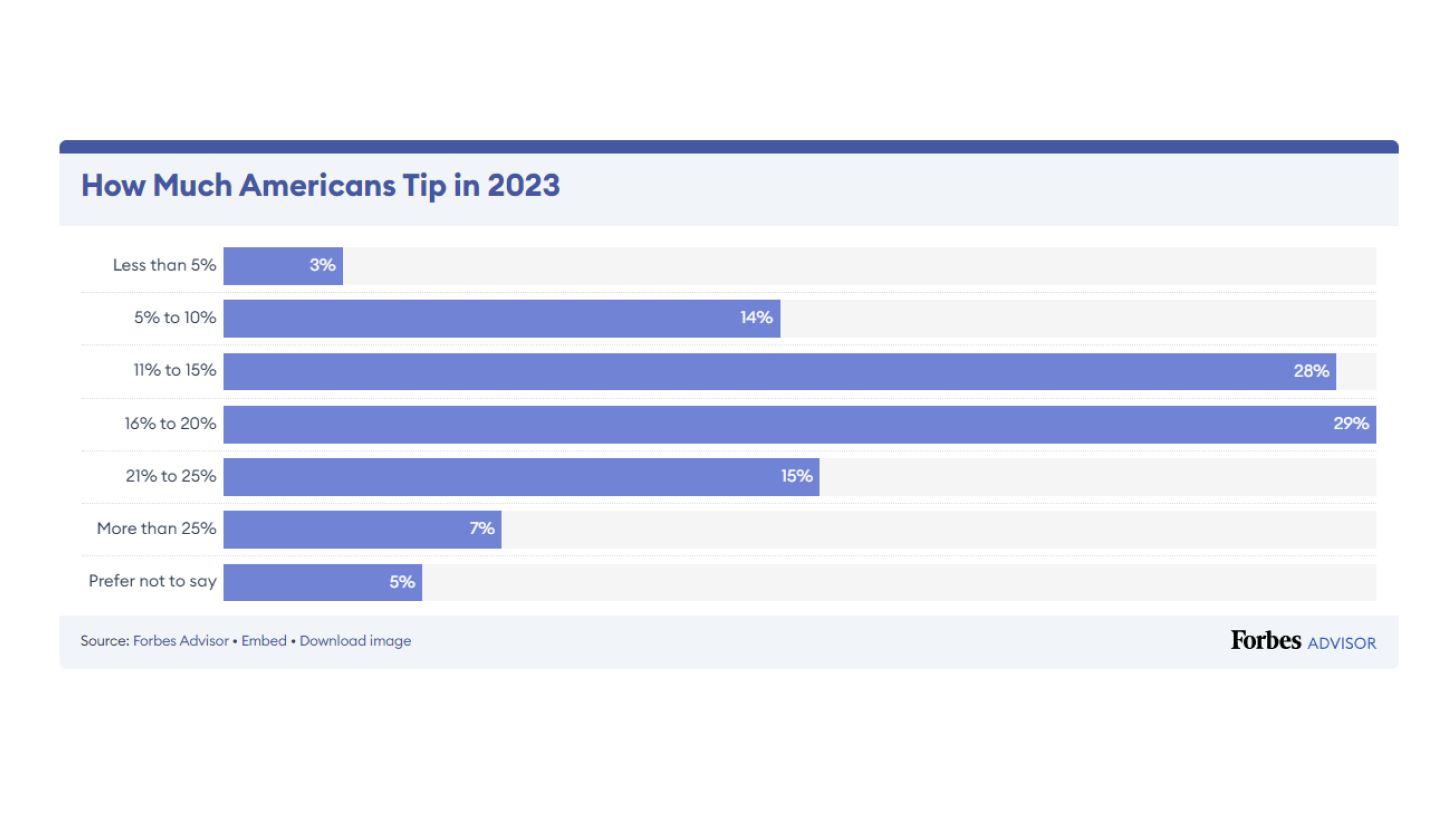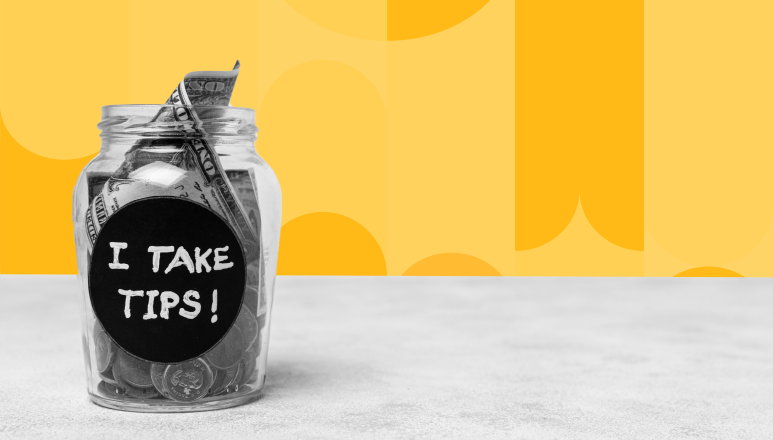The transformation isn’t solely numerical; as digital payment methods dominate transactions, the ubiquitous black credit card machine prompts you to decide on a tip nearly every time you make a purchase 1.
Moreover, the rules themselves have become increasingly ambiguous. Should you leave a tip at spas? Starbucks? What about your Uber driver?
This article aims to articulate the unwritten rules of tipping in the United States and delineate the expected tipping norms for various situations.
Tipping Guidelines for Various Situations
No beating around the bush here! Listed below are various services where the question of whether to tip and how much might cross your mind. However, keep in mind that the appropriate tip should always be situation-dependent. Exceptional service deserves a bit more, while exceptionally poor service might warrant a smaller tip.
Tipping stands out as the optimal means to express gratitude for service and is universally valued by service providers.
Dining Etiquette for Restaurants
- In-house Dining: 15-20%
- Takeout: No tipping necessary.
While tipping can be a source of ambiguity in various industries, restaurants stand out as a clear exception. Amongst all services, sit-down restaurants consistently top the list where tipping is customary.
For a visual breakdown of how frequently individuals tip across different services, check out this infographic crafted by Bankrate.

Gratuity Guidelines in Various Services
Delivery Services:
– Food delivery: $5. If it’s an unusually large order, consider 15% as it might have been more challenging for the driver/cyclist.
– Grocery delivery: 15-20%
Ride-share:
– Uber, Lyft: 10-20%
– Taxi: 15-20%
– Limo: 10-20%
– Airport shuttle bus driver: $2-3. If they assist with your bags, then $3-5.
Coffee Shops:
– Skill-based drinks: $1. This covers steamed milk drinks or intricate concoctions.
– Simple drinks: No need to tip for basic beverages like drip coffee or a tea bag.
Bars:
– Beer: $1-2 per drink
– Wine: $1-3 per glass. Towards the higher end for upscale wines or if the bartender guides you through the selection.
– Cocktails: $2-5 per drink. More for exceptionally complex drinks or outstanding service.
– Drink tab: 15-20% of your bar tab if you’ve indulged in multiple drinks during your bar visit.
Salons and Barber Shops:
– Barber/hairstylist: 15-20%
– Massage: 15-20%
– Manicurist: 15-20%
– Facial: 15-20%
However, it’s advisable to tip a bit more if you’re a regular. For instance, if you frequent the same barber monthly and have established a relationship, showing respect by increasing your tip by a few percentage points is a thoughtful gesture.
Childcare:
– Babysitting: $5-10 a day. Consider extra for late hours or short-notice requests.
– Nannying: No tip needed. However, at year-end, offering a bonus matching one to four weeks’ worth of their salary is a thoughtful gesture. A birthday gift is also a nice touch.
– Au pair: No tip required. Consider a birthday gift or holiday bonus matching their stipend for one to four weeks.
Movers:
– Movers: $5 per person per hour. Increase for challenging moves—many stairs, no elevator, hot weather, etc. Offering food and beverages is also appreciated.
Hotel Services:
– Bellhop: $5 for a few bags; for families with many bags, $1-5 per bag.
– Housekeeper: $2-4 per day. In high-end hotels, consider $5-10. Tip daily instead of at the end of your stay.
– Concierge: No tip for basic requests; $5-10 if they assist with reservations or event tickets.
– Room service: 15-20% (if gratuity wasn’t included).
– Doorperson: No tip for holding the door; $1-5 if they assist with bags or hail a cab.
Valet:
– Valet driver: $2-5 when picking up the car.
Tattoos:
– Tattoo artist: 15-30%.
– Tiny tattoos: 25-30%. Consider more for shop minimums as it claims the artist’s time.
– Creative collaboration: 25-30%. If the artist creatively invests in the project and helps design your tattoo, reflecting that in the tip is appreciated.
Spas
Tipping Gray Areas
Food truck workers
- Food trucks: Fifty cents to $2. 10% if an order is over $30
This one is slightly controversial. Forty percent 2 think food truck workers should not ask for tips.

While food truck workers aren’t filling your water or checking in on your eating experience, they differ from fast food chains in that the money goes into the owners’ pocket and fuels your local economy.
Takeout and Fast Food:
– Takeout service: No tip needed.
– Fast food workers: No tip necessary. A significant 38% of Americans think fast-casual restaurants shouldn’t ask for tips.
Pet Services:
– Dog walkers: No tip expected, but it can be a good gesture for regular and reliable service.
– Pet sitters: No tip necessary, but consistent use can show respect and earn loyalty.
– Dog and cat groomers: Tip pet groomers 15-20%, akin to a human hair stylist.
When Gratuity is Added:
– Services with included gratuity: No extra tip needed. Assess if additional tipping is deserved.
Drive-throughs and Self-Service Restaurants:
– Drive-through workers: No tip necessary.
– Self-service eating: Tipping is not required.
Grocery Store Services:
– Curbside pickup: No need to tip.
Contract Workers (Plumber, Electrician, etc.):
– Plumbers, Electricians, Cable technicians, Landscapers: No tip expected. A holiday gift of one week’s worth can be a nice gesture for regular service.
Fitness Teachers (Yoga, Personal Trainers, Dance Instructors, Fitness Instructors):
– Tipping is not expected.
Market Vendors:
– Artisans, Craft Makers: No need to tip.
– Farmers market produce vendors: Tipping is optional.
Therapists and Coaches:
– Therapists: No need to tip; it’s often discouraged to maintain professional boundaries.
– Life coaches: Tipping is not expected; referrals are preferred.
Unwritten Rules of Tipping Etiquette:
– When in doubt, go with 15-20%: Default to this range for unfamiliar tipping scenarios. According to Forbes 2, 16-20% is the most common tipping range among Americans.

For certain professions, tipping is not optional; it’s part of their income (in many states)
It’s true, tipping is not just a nicety in certain professions; it’s a crucial part of their income, especially in states where tip-based industries have a lower minimum wage. In Oklahoma, for instance, the minimum wage 3 for tip-based jobs is a mere $2.13 per hour. That’s $85 for a 40-hour workweek, highlighting the significant role tips play in ensuring a livable income for workers.
If you’re curious about the tip-based minimum wage in your state, you can refer to this table.
This system might seem a bit peculiar, but in some industries, tipping is essential for the livelihood of the workers. The situation becomes a bit more nuanced in industries like coffee shops, where baristas often earn minimum wage alongside tips.
While many service industry professionals are financially stable, employees in tipped professions are three times more likely to rely on food stamps compared to their counterparts. As illustrated below, workers in tipped professions are also more prone to living below the poverty line, emphasizing the financial significance of tips in these sectors.

Absolutely, whether one agrees with the concept of tipping or not, it’s crucial to recognize that in certain professions, tips play a pivotal role in ensuring a livable wage for workers. Avoiding tipping in these situations can indeed impact someone’s ability to make ends meet and contribute to a sustainable income. The debate about the tipping system aside, acknowledging the financial reality for individuals in tip-dependent jobs is essential.
Resisting Tipping Pressure: Navigating the Screen Dilemma
Absolutely, you hit the nail on the head! The constant prompts for tips on screens can create a sense of confusion and pressure. It’s important to stay true to your own judgment and not feel obligated to tip, especially in scenarios like a fast-food drive-through where it’s not customary. No need to succumb to the digital pressure – be as bold as George in the GIF and make tipping decisions based on your own terms.
Greetings! I need you to rephrase the sentences in the text while preserving its structure, meaning, and size, and indicating the location of references as in the original text. In English.
Heartfelt expressions of gratitude are wonderful, but they don’t cover living expenses.
If you value someone’s service, a sincere thank you can have a significant impact. Often, it can resonate more deeply with a person than a monetary tip.
Nevertheless, words alone cannot settle bills or purchase groceries. In industries where tipping is the norm, an authentic “thank you” should go hand in hand with the tip, not substitute for it.
Give a Little Extra for Exceptional Service
When the service goes beyond the ordinary—be it a waiter’s stellar recommendations or a barber’s meticulous attention to detail—acknowledge the outstanding effort with a tip that exceeds the standard amount.
If the server’s personality and attentiveness elevate your overall experience, that’s a clear signal to be more generous with your tip.
Recognize Skill and Effort with Generous Tips
When in doubt about tipping, a common guideline is to be more generous for services that demand greater skill or effort. Consider tipping extra for a skillfully crafted cocktail compared to a simple beer. Similarly, show appreciation for the extra effort of movers, especially if you reside on the 10th floor without an elevator.
Acknowledge Special Requests with Additional Tips
When making custom requests or last-minute changes, it’s worth considering a larger tip for service professionals. These demands, whether it’s a complex order such as an espresso with multiple bean varieties and a unique foam blend or a barrage of questions, can be challenging. For a humorous take on this, check out this classic skit from Portlandia: https://youtu.be/ErRHJlE4PGI
Express Appreciation for Extended Hours with a Generous Tip
If you find yourself entering a restaurant a minute before the kitchen closes or slipping into a barbershop just before closing time, consider tipping more. While it’s not inherently wrong to do so, it’s worth acknowledging that workers may be eager to wrap up after a long day, and staying late can be tiring for them.
During a recent visit to Plymouth, England, I experienced a situation where we arrived at a pub right as it was closing. The bartender initially turned us away, but my friend, adept at persuasion, managed to secure us one drink. In this unspoken yet implicit agreement, acknowledging the extended service with a generous tip became a way to express gratitude for accommodating us late into closing hours.
Consider Referring in Certain Industries
In specific sectors, providing a referral can be as impactful, if not more so, than tipping directly. This is particularly true in professions such as landscaping, hairdressing, or personal training. For self-employed service workers reliant on a steady clientele, a referral serves as a significant gift, aiding them in business expansion. While tipping shows immediate appreciation, referring can contribute to their long-term success.
Embrace Tipping as an Act of Generosity
A notable 31% 2 of individuals admit feeling pressured when tipping, while 36% find joy in the practice. Tipping can evoke a range of emotions; there are instances when financial constraints make it seem burdensome, while other times, it feels fulfilling to express appreciation through monetary gestures.
To actively engage in tipping culture, it’s beneficial to acknowledge that tipping is part of the process. Rather than resisting it, accepting this reality reframes the act of tipping. When viewed as a generous and abundant contribution, tipping becomes a positive experience for both the giver and the recipient.
For some inspiration, watch this heartwarming video where a patron gives a $1,300 tip to a waitress: https://youtu.be/Np8O3QjPPks
Navigating Tricky Tipping Scenarios
With the basic principles of tipping in mind, let’s delve into some intricate tipping situations that might have left you uncertain about the appropriate course of action.
Handling the Watchful Server
Stick to your personal assessment of an appropriate tip based on the service you received. Establishing a standard tipping percentage beforehand can be beneficial for such situations. It’s crucial not to tip beyond your comfort level due to external pressure.
If you experienced discomfort or felt pressured, consider providing feedback to the restaurant management. Your input can help create a more comfortable and respectful dining environment for both patrons and staff.
Navigating Different Tipping Preferences During a Split Bill
Initiate a polite conversation about the differing tipping approaches. Recognize that each of you may have distinct tipping philosophies influenced by personal views, financial situations, or mood.
When splitting the bill, it’s often simplest to tip what you consider fair for the portion you are covering. Establishing open communication helps ensure a respectful resolution and avoids potential misunderstandings.
Dealing with Disappointing Service
In cases where the service falls below your expectations—perhaps the waiter was abrupt, the food was delayed without explanation, or you faced difficulties getting water refills—contemplate tipping slightly less than your usual amount. However, it’s advisable to include some tip, typically around 10%.
Rather than opting for retaliation by entirely omitting the tip, a more constructive approach is to provide feedback to the establishment. Offering constructive criticism can contribute to improvements and foster a better dining experience for future patrons.
Adhering to a No-Tip Policy at the Restaurant
Show respect for the establishment’s policy, as it’s likely in place to ensure fair wages for their staff. In certain places, like Seattle, some cafes have adopted a policy of including a tip in all orders, eliminating the need for customers to worry about tipping.
If you encounter exceptional service and want to express gratitude, consider other means aside from tipping. This could involve offering positive feedback, leaving a glowing review, or personally thanking the staff. Finding alternative ways to acknowledge excellent service within the boundaries of the established policy is a thoughtful approach.
Tipping with Coupons or Gift Cards
Even if you’ve paid with a coupon or gift card, it’s important to continue tipping. Always calculate your tip based on the original bill amount before any discounts or deductions. The server’s efforts shouldn’t be undervalued simply because you have a discount, and it’s fair to acknowledge and appreciate their full service.
Tipping Etiquette Around the World
Tipping is deeply ingrained in American culture, but practices vary across countries. Here’s a glimpse of tipping norms in several places:
Canada:
Similar to the U.S., tipping is common, with a typical range of 15-20% in restaurants and similar expectations in other service professions.
United Kingdom:
A service charge of approximately 12.5% may be added in restaurants, and if not, leaving around a 10% tip is polite. Tipping is common in pubs only when table service is provided.
Australia:
Tipping is less prevalent but appreciated. In upscale restaurants, a tip of around 10% for exceptional service is common.
Japan:
Tipping isn’t customary and can be considered rude in some contexts. Exceptional service is typically included in the overall price.
China:
Traditionally uncommon, tipping is gaining acceptance in tourist-centric areas and international hotels.
France:
Service charges are mandated by law, but leaving small changes is common. In upscale restaurants, a 5-10% tip is appreciated for excellent service.
Italy:
A service charge (“coperto”) covering bread, oil, and salt is often added. While not expected, tipping is appreciated, especially for outstanding service.
Brazil:
A 10% service charge is commonly added to restaurant bills, though not obligatory. Additional tipping is infrequent.
India:
A 10% service charge may be added in restaurants, and if not, a tip of around 10% is appreciated. Small tips are customary for porters, drivers, and other service workers.
Mexico:
Tipping is expected, with a standard range of 10-15% in restaurants unless a service charge is included. Small tips are also customary for various services.
Egypt:
“Tipping” or “baksheesh” is integral to Egyptian culture. Small tips are expected for various services, with a customary 10-15% on top of any service charge in restaurants.
While these are general guidelines, tipping customs can vary between urban and rural areas. If you’re uncertain while traveling, seek advice from locals to navigate tipping etiquette effectively.
Tipping Etiquette FAQs
What is tipping etiquette, and why is it important?
Tipping etiquette is the customary practice of offering extra money to service workers as a gesture of appreciation for their services. It is important as it acknowledges their efforts and often supplements their income.
When should I tip, and how much should I give in various situations?
You should tip for personal services, and the amount varies: 15-20% for dining, 10-20% for taxis, and $1-2 per bag for porters. Always consider the service quality and adhere to local customs.
Are there different tipping customs in other countries and cultures?
Yes, tipping customs can vary widely between countries and cultures, ranging from expecting generous tips to considering it unnecessary or rude.
What should I do if a gratuity is already included in the bill?
If a gratuity is already included in the bill, you generally don’t need to tip extra. However, for exceptional service, you can choose to provide an additional amount.
Should I tip for takeout orders or delivery services?
Yes, it’s customary to tip for delivery services, typically around 10-15%. While tipping for takeout orders isn’t expected, a small tip is appreciated for good service.
Is it necessary to tip for services like haircuts or massages?
Yes, it’s customary to tip for personal care services like haircuts or massages, generally around 10-20% of the total bill, depending on the quality of service.
How can I show appreciation for exceptional service without tipping?
To express appreciation without tipping, provide positive feedback directly to the worker or their management, write a favorable online review, or recommend their services to others. However, in professions relying on tips, it’s best to give positive feedback in addition to the tip rather than as a substitute.
Key Points on Tipping Etiquette
Tipping can indeed be perplexing, but adhering to the guidelines above will keep you in tip-top shape. Beyond specific numbers, remember these principles that define tipping etiquette:
- When uncertain, opt for 15-20%. It’s the safest choice.
- Tipping is not discretionary for certain professions; it’s a vital part of their income.
- You aren’t obligated to tip just because a screen prompts you. Fast food restaurants or farmers’ markets typically don’t require tipping.
- Heartfelt thank yous are valuable but don’t replace a tip. Gratitude is significant, but it doesn’t pay bills.
- Tip extra for outstanding work. If the server significantly enhances your experience, consider a more generous tip.
- Recognize skill or effort. Orders demanding extra effort or skill deserve a larger tip.
- If you make special requests, consider tipping more. Whether a complex order or a series of questions.
- Express gratitude for extended hours with a tip.
- Provide referrals for self-employed services. Therapists, coaches, and massage therapists rely on relationships, making referrals highly beneficial.
- View tipping as an act of generosity. While tipping might make some uneasy, accepting it as common practice allows for wholehearted giving.
Now you’re clear on when to tip and how much! It’s an excellent way to show appreciation and brighten someone’s day. If you’re interested in more ideas for spreading cheer, check out this course: LIAR OR LEGIT?



